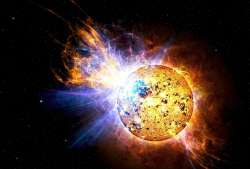Scientists detect superflares '10 million times' more energetic that of Sun
The most technologically advanced telescopes at the European Southern Observatory, Chile, have spotted superflares that are '10 million times more energetic than those on the sun'. An international team of scientists, working on the project, examined stellar objects called 'extreme horizontal branch stars' (EHB) that are found in tightly packed stellar groups called globular clusters.

The most technologically advanced telescopes at the European Southern Observatory, Chile, have spotted superflares that are '10 million times more energetic than those on the sun'. An international team of scientists, working on the project, examined stellar objects called 'extreme horizontal branch stars' (EHB) that are found in tightly packed stellar groups called globular clusters.
Surprisingly, however, the vast majority of these extreme horizontal branch stars, when observed in globular clusters, do not appear to have companions. The team’s long-term monitoring of these stars, made with ESO telescopes, also revealed that there was something more to these mysterious objects. "When looking at three different globular clusters, Momany and his colleagues found that many of the extreme horizontal branch stars within them showed regular changes in their brightness over the course of just a few days to several weeks," ESO said in a statement.
“After eliminating all other scenarios, there was only one remaining possibility to explain their observed brightness variations,” concludes Simone Zaggia, a study co-author from the INAF Astronomical Observatory of Padua in Italy and a former ESO Fellow: “these stars must be plagued by spots!”
Researchers say that EHB may hold the answer to a mystery in the stellar evolutionary theory - how and why do stars like the Sun lose as much as 30-40 percent of their mass during their final evolutionary stages?
After six decades of trying to understand extreme horizontal branch stars, astronomers now have a more complete picture of them. Moreover, this finding could help explain the origin of strong magnetic fields in many white dwarfs, objects that represent the final stage in the life of Sun-like stars and show similarities to extreme horizontal branch stars. “The bigger picture though,” says team member, David Jones, a former ESO Fellow now at the Instituto de Astrofísica de Canarias, Spain, “is that changes in brightness of all hot stars — from young Sun-like stars to old extreme horizontal branch stars and long-dead white dwarfs — could all be connected. These objects can thus be understood as collectively suffering from magnetic spots on their surfaces.”